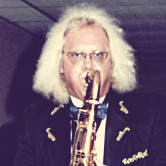Mouthpiece Facings, Chambers, and Materials
Paul R. Coats
A young saxophonist usually purchases a new mouthpiece during his junior high or high school years, either because of damage to his “stock” mouthpiece or the desire for an improved tone. He will usually be advised to buy a particular brand and size (Selmer C*, etc.) or, more vaguely, a “medium size” facing. Even worse, he may be told to buy a size number without being aware there are no standard size numbers. Facing sizes are numbered, or lettered, differently by each manufacturer, a #4 in one brand may be the same size as a #3 or letter size in another brand. Also, a facing that is considered “medium” for jazz or rock is “open” for concert band or “classical” playing.
In general, classical and concert band mouthpieces have large, round chambers which produce a tone quality rich in fundamental and low overtones. These mouthpieces are usually played with moderate tip openings (the gap between the tip of the reed and tip of the mouthpiece) and reeds in the #3 to #3 1/2 range.
Jazz type mouthpieces generally have smaller, more square chambers, which encourage production of higher overtones. This gives more “edge”, or brilliance to the tone. These mouthpieces are usually played with tip openings about .010″ to .015″ larger than classical mouthpieces, and with softer reeds (#2 to #2 1/2).
Small tip openings require hard reeds to keep from choking up at loud volumes, have less flexibility in pitch, and have a cold, hard tone. Larger tip openings allow more flexibility in pitch, which is great for jazz, but may cause problems for young players. Large tip openings require softer reeds, and may cause embouchure fatigue.
The chamber and material of the mouthpiece have a greater effect on tone quality than the tip opening. Changing only the tip opening will cause a subtle change in tone quality in that softer reeds are used, which vibrate with more rich overtones.
It is a common misconception that metal mouthpieces are only for jazz, and that hard rubber (or plastic) mouthpieces are for concert playing. This idea has probably come about from the number of jazz saxophonists, usually tenor players, who use metal mouthpieces. Hard rubber or plastic mouthpieces vibrate and add overtones to the sound. Metal mouthpieces damp vibration. The old big band tenor men wanted a smooth, warm tone, not a bright edgy rock and roll tone as is common now. The most common metal mouthpiece used by them was the Otto Link metal, which has a large round chamber, and produces a dark, “hollow” tone. The Selmer (Paris) metal mouthpiece is a very fine classical type mouthpiece and is used by Dr. Frederick Hemke and many other fine artists.
Another quality of metal (and plastic/synthetic) mouthpieces is durability. Hard rubber is a poor material for mouthpieces even though it is easy to tool and to set into vibration when played. Hard rubber breaks easily when bumped, warps over time or from heat (even from sunlight), and wears on the tip and side rails from reed vibration. Crystal holds the facing well, but is easily chipped if bumped. Wood cracks easily and warps from the effects of moisture and temperature. For these reasons wood and crystal are not suitable materials for saxophone mouthpieces.


